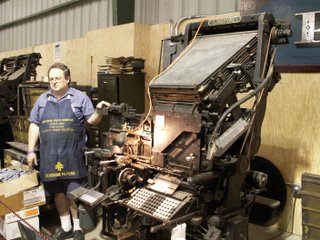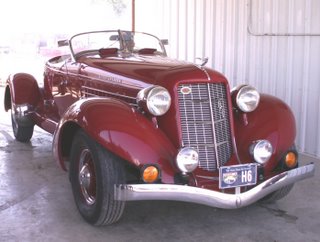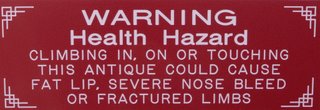Every year since the 1950s, there has been a festival in Mount Pleasant Iowa known as the Old Threshers Reunion. In the past it was exactly what the name implied; a reunion of old threshermen. People gathered to remember their common history as members of America's agricultural system and to admire the old technology that once supported them on the farm. It has grown to be much more. This is now one of the few places where the old ways of life are being preserved for future generations.
Back about 1960, when the reunion was still young, a group of supporters decided they wanted to offer something more to the festival that other antique machinery shows did not have; a railway. Equipment was purchased, track (3 foot gauge) was laid and the Midwest Central Railroad was born.
Now, the MCRR has 3 operable steam locomotives a roster of cars that lets them operate near continuous passenger train service throughout the Old Threshers Reunion as well as on special events throughout the year. Below is engine number 6, a 2-6-0 type steam locomotive which was purchased from the Argent Lumber Company where it worked up until the 1950s hauling timber out of the swamps of South Carolina.
 Today number 6 has been restored to a condition so pristine that it could be mistaken for a brand new engine.
Today number 6 has been restored to a condition so pristine that it could be mistaken for a brand new engine.
Steam trains aren't the only things on rails here. The Midwest Electric Railway operates a fleet of old trolleys on the south end of the fairgrounds. Their collection contains cars from 3 continents and stretches back to before WW I.
In case the real thing isn't enough there are even models on display. I don't mean little electric trains either, these are scaled down versions of the real thing!
 The models aren't limited to trains either. There are model steam traction engines, stationary steam engines, and gas engines too!
The models aren't limited to trains either. There are model steam traction engines, stationary steam engines, and gas engines too!
For several years now, Old threshers has had it's own print-shop for printing items like fliers and business cards. This year they have expanded it so that they are printing their own newspaper. I expect the print shop will increase it's capabilities even more as it restores several Linotype machines like the one below. Any review of old technology would be incomplete without saying a few words about device that helped the industrial revolution escape from the confines of waterwheels and beasts of burden. The stationary steam engine made it possible to run large amounts of machinery at consistent speeds with relatively little dependence upon human interaction or natural energy sources.
Any review of old technology would be incomplete without saying a few words about device that helped the industrial revolution escape from the confines of waterwheels and beasts of burden. The stationary steam engine made it possible to run large amounts of machinery at consistent speeds with relatively little dependence upon human interaction or natural energy sources.
Strangely enough the boilers and steam pistons that drive these machines are of fairly little consequence on their own. It is only when they are combined with a crankshaft and valve-gear that they become truly useful, because they are then capable of producing constant rotary motion. Add a flywheel to smooth out the flow of power (through the use of momentum) and a governor (to control the speed without constant human supervision) and you have the makings of a great piece of engineering.
And as time marches on, we move from steam to gasoline.
 The gas engines of this type were made in much the same way that their steam driven ancestors were designed. Basically, the energy from the combustion chamber was used to build up energy in a large flywheel. This smoothed out the flow of power, which was necessary because unlike most modern engines they are designed to make multiple rotations without a power stroke. They use a typical 4 cycle design (intake, compression, power, exhaust) but only when the speed dropped below a specified point. The rest of the time, the engine simply coasted with a valve open for pressure relief.
The gas engines of this type were made in much the same way that their steam driven ancestors were designed. Basically, the energy from the combustion chamber was used to build up energy in a large flywheel. This smoothed out the flow of power, which was necessary because unlike most modern engines they are designed to make multiple rotations without a power stroke. They use a typical 4 cycle design (intake, compression, power, exhaust) but only when the speed dropped below a specified point. The rest of the time, the engine simply coasted with a valve open for pressure relief.Speaking of gas engines, the car collectors of Midwest Old Thresher have some of the prettiest examples of how to use a gasoline powered engine. As far as IÂ’m concerned, cars like this Auburn boat-tail are more appealing than any modern car on the market.

Of course, some motor vehicles are designed with the intent of doing hard labor. With this in mind, Old Threshers has a huge selection of antique tractors of all sorts. This is just a small portion of the tractor section
Most of the collectors here are quite good natured with a good sense of humor. I spotted this on anabsolutelyy pristine old IHC tractor.
 I'm pretty sure this wastonguee-in-cheek. Still, I didn't climb up onto this tractor. I did, however, get to try my hand at running another form of tractor.
I'm pretty sure this wastonguee-in-cheek. Still, I didn't climb up onto this tractor. I did, however, get to try my hand at running another form of tractor.
 One of the steam tractor operators was kind enough to let me try to run his tractor (not drive mind you, just run the motor.) It's not quite as simple as running a modern day machine because the way a steam engine is set-up requires that you use the valve gear lever to set the direction (and power) of the engine, in addition to using the throttle to set the speed. To top it off, it's common to have the engine stop in a position where it cannot be turned in the desired direction, so one must learn to 'rock' the engine to get it moving properly.
One of the steam tractor operators was kind enough to let me try to run his tractor (not drive mind you, just run the motor.) It's not quite as simple as running a modern day machine because the way a steam engine is set-up requires that you use the valve gear lever to set the direction (and power) of the engine, in addition to using the throttle to set the speed. To top it off, it's common to have the engine stop in a position where it cannot be turned in the desired direction, so one must learn to 'rock' the engine to get it moving properly.
There's much more to cover, but that's a pretty good synopsis of the event. Over the next few months I'll be doing more posts on the festival and the old technology that is displayed there.



4 comments:
Railfans should look at the book "The American Heritage History of Rairoads in America" by Oliver Jensen, copyright 1975. The Number 6 engine is seen on page 307 in the South Carolina swamps fifty years ago.
Great post and pictures! Thanks.....
..... Mr. C.
EJ,
I've made the trip to "Ole Thrashers" five times in the last 20 years and have completely enjoyed myself every time. It's really like stepping into about a 1940-50 county fair that has more farm equipment than is reasonable. The last time I went I particularly enjoyed the horse (of the equine variety) powered events.
It's truly a family affair and I've taken my children (and the wife who loved it) 3 times. It's full of friendly people and I've made many long-standing friendships with the regulars there (particulary Johnny Weyer who runs the radio museum at the west of bldg. 2).
It's truly a fantastic piece of Americana.
RK,
Indeed! I've been going there since I was quite young.
I spent some talking with Mr. Weyer this last time. He's a really wonderful man who seems to enjoy what he's doing there. It was particularly nice for me because we both have quite an affinity for old fashioned record players.
Mr. Completely,
Glad you liked it!
Post a Comment